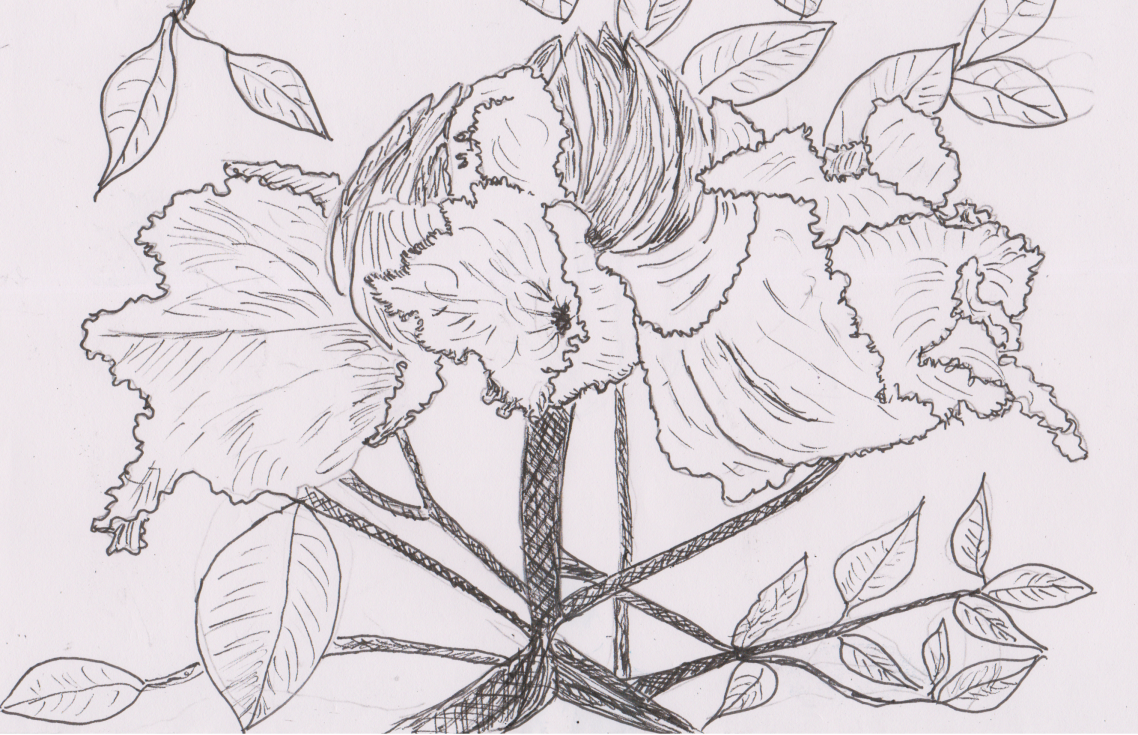On September 12, 1962, John F. Kennedy spoke these famous words:
We choose to go to the moon in this decade and do the other things, not because they are easy, but because they are hard…
And that’s precisely why I chose to do this drawing of a bloom on the African Tulip Tree.

When my monkey mind and I went traipsing after our search words — squeeze, deep, breakable, tread, tree — we ended up with tulip tree. Soon, we learned that there are several varieties of tulip trees which are related to the magnolia.
The one that caught my eye, however, was the African Tulip or Spathodea campanulata, which is a very large tree, native to Africa. It’s sometimes called Flame of the Forest because of its large red flowers.
Spathodea campanulata or African Tulip is native to Africa, where it reaches heights up to 60′ tall. Outside of the native habitat, heights of around 25′ are average. In the winter, the tree is covered with nectar-rich, vibrant orange, cup-shaped flowers which attract hummingbirds and other wildlife. Water, nectar, and insects will collect inside upturned blooms, making the tree a favored bird hangout. — Emerald Goddess Garden
But how could I ever draw such a frilly flower with all its ragged edges? Could I actually do it? Probably not, but I wanted to try.
When I first began learning to draw, I copied illustrations from Kate Berry’s book, Drawing Lessons for Beginner Artists. Most of those illustrations were leaves and flowers, and her words comforted me. Don’t worry about all those fussy little bits, she advised. Just draw what you can. Those aren’t her exact words, but her point was that as a beginning artist I didn’t need to concern myself with botanical accuracy. I didn’t have to capture every little vein in every leaf or petal. I didn’t have to show detailed stems or stamens, or any of those other fussy little bits.
I approached today’s drawing with that thought in mind. Yes, I wanted a few of the fussy bits — the jaggedness of the flower’s edges — but I didn’t worry about getting any of it just right.
Another principle in drawing is that we shouldn’t try to draw anything we don’t understand, and from that point of view, I should never have attempted this flower from this tree. I followed the outlines of the petals in my reference photo, but even then, it was hard to tell one petal from another. Same with the leaves and the branches. I concentrated on making a basic outline drawing, trying to simplify the overall design so that it became do-able for me.
As I inked over my graphite outlines, I really couldn’t tell what was what, and I didn’t care. I could have looked longer and harder at that reference photo, but instead I just went with instinct, I guess you’d call it. I added bits of ink-shading here and there to suggest the shape of the petals. Maybe in places I added too many marks; maybe in other places, I didn’t add enough.
I added leaves, too. They were blurry and indistinct in the original reference photo, so I didn’t worry about the exact placement. I just put leaves where I felt they should be, places where I thought — or hoped — they might look right.
And when all was said and done, I liked my drawing. It’s filled with imperfections, and even now I can’t say that I understand the structure of this flame of the forest flower. A lot of my original pencil marks are still there, too, although I tried to erase them.
I enjoyed making this drawing, playing around with a few fussy little bits, but feeling all right about leaving out a lot of them. It was a chance to push myself a little farther with ink drawing, but not so far that I felt discouraged or disappointed.
So, I’m not a botanical artist. That’s fine with me. While I admire their accurate, detailed drawings, I don’t want to get so caught up in fussy little bits that I lose the enjoyment in creating art.
 AND WHAT AWAITS US TOMORROW?
AND WHAT AWAITS US TOMORROW?
- Big
- Furious
- Drain
- Treasure
- Tree
Cheeky Monkey Mind hopes you’ll visit us tomorrow to find out!

Tell me a bit about drawing what you understand. What does that mean?
LikeLiked by 1 person
To me, it means that if you don’t really understand the structure of what you’re looking at, that you probably won’t be able to draw it accurately. Like if I try to draw a ship… I don’t really know what all the different parts are for or how they fit together, so it would be difficult for me to draw it correctly. That’s how I interpret that advice. With this tulip tree bloom, as an example, it was very hard to tell from the reference photo where each petal attached. Parts of the photo were a bit blurry and indistinct. Since I’m not personally familiar with these African tulip trees, I couldn’t really “understand” how everything fit together. I hope that makes a little sense. 🙂
LikeLiked by 1 person
Oh it makes a lot of sense. A light just went on for me! Thanks!
LikeLiked by 1 person
Glad it helped! It’s always fun when those little light-bulbs go off. 🙂
LikeLike
It is.
LikeLiked by 1 person